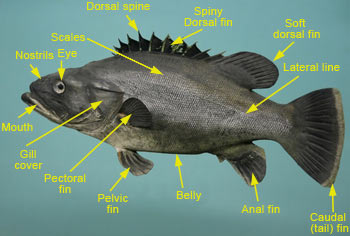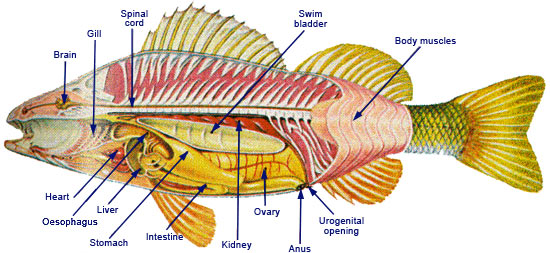Fish
The fins are composed of bony spines protruding from the body with skin covering them and joining them together. Fins are used for movement, stability, nest-building, spawning, and as organs of touch. They can be single or paired. The caudal or tail fin is used for propulsion. Fish that have forked caudal fins usually are fast swimmers. The anal fin stabilizes the fish and provides propulasion while it is swimming. Ventral fins are also used to provide stability in swimming. The paired pectoral fins are used for manoeuvering the fish.
The single dorsal fin helps balance the fish while swimming. The rays of this fin are often sharp, and a spine is often present.
The lateral line organ is a series of fluid-filled ducts located just under the scales. The lateral line system picks up vibrations in the water allowing fish to detect predators, find food and navigate more efficiently.
|

|
| |
|
The swim bladder is an air-filled bladder (elastic, muscular sac usually filled with air or water) used for keeping the fish in a state of neutral buoyancy where they neither sink nor float. This allows fish to be able to sleep in mid water. Some species can swallow air, which is passed to the swim bladder, where the oxygen is removed.
Gills are respiratory organ found in many aquatic animals that remove dissolved oxygen from water, Gills usually consist of thin filaments of tissue, branches or slender tufted processes that have a highly folded surface to increase surface area to allow more oxygen to be extracted from the water. Water is swallowed or pushed into the mouth and over the gills by rapidly swimming forward. |

|
| |
|
Fish reproduce sexually, the eggs develop outside the mother's body in over 97% of fish with sperm and eggs released into the water. Marine fish can produce high numbers of eggs with an average diameter of one millimetre. The newly hatched larvae, carrying a large yolk sac, go through a rapid growth stage to become juveniles.
In some fish, often called livebearers, the eggs develop inside the mother's body after internal fertilization but receive little or no nourishment directly from the mother, depending instead on the yolk.
Fish are found at almost trophic level of aquatic food webs. Some fish eat phytoplankton and or zooplankton, others are herbivores eating seaweeds. Fish (e.g. sharks) are also top-order predators. Other fish are omnivores, scavengers, detrtitovores and parasites. Fish are also by many other fish and a very wide range of animals from mammals to jellyfish. |


|
| |
|
| |
|
| |
|
Next: Bony fish ... |
|